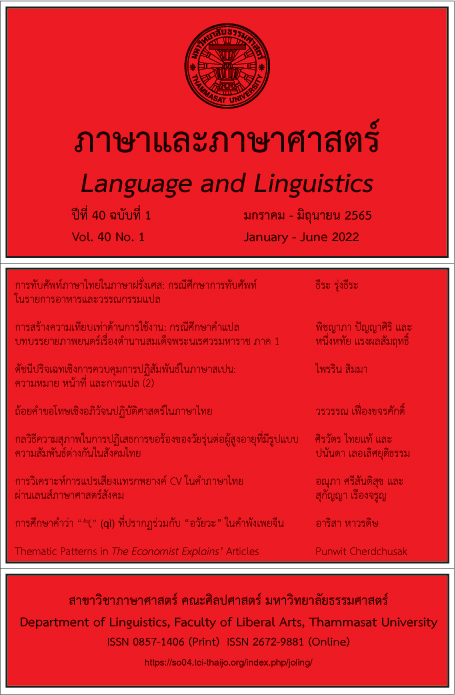The Research on Chinese Idioms with “气” (qì) in the scope of "organs"
Main Article Content
Abstract
This research article aims to study the word “气” (qì) within the framework of a study of words related to organs in Chinese idioms. The research found that there are 80 idioms, divided into words where “气” (qì) appears with “心” (xīn, heart), being the greatest number. The word “气” (qì) also appears with “血” (xuè, blood), “胆” (dǎn, gallbladder), “肠” (cháng, intestine), “眉” (méi, eyebrows), “胸、胸脯、膺” (xiōng, xiōngpú, yīng, chest), “足” (zú, feet), “颐” (yí, cheeks), “身体、体” (shēntǐ, tǐ, body), “头” (tóu, head), “骨” (gǔ, bone), “腹” (fù, belly), “喉” (hóu, pharynx), “目” (mù, eyes), “脉” (mài, vein), and “牙” (yá, tooth) in respectively. In addition, this research also found that the meaning expressed by each of the organs is different. It could be summarized as follows: each organ expresses meanings about attitude, expression, personality, courage, fear, strength, state of health, emotion, feeling or state of mind, such as depression, disillusionment, anger, sadness, happiness, joy, calm or restless mood. It can be concluded that the word “气” (qì) when appearing together with words related to the organs is meant to express nonphysical attributes. In Chinese idioms, meanings are shared by these linguistic methods called Conceptual Metaphor. It can be categorized as follows: expressing meanings about emotions, feelings, mental states, about mannerisms, medical health and physical conditions.
Article Details

This work is licensed under a Creative Commons Attribution-NonCommercial-NoDerivatives 4.0 International License.
บทความทุกบทความเป็นลิขสิทธิ์ของภาษาและภาษาศาสตร์
References
ซือฉี เหยา. (2562). อุปลักษณ์ “心 /ɕin55/ (ใจ)” กับรากฐานแห่งวัฒนธรรมจีน: การวิเคราะห์ตามแนวทฤษฎีการหลอมรวมความคิด. วารสารภาษาและวัฒนธรรม, 38(1), 105-134.
เผย์ เสี่ยวรุ่ย. (2546). พจนานุกรมจีน-ไทย. สำนักพิมพ์ทฤษฎี.
อาริสา หาวรดิษ. (2560). เปรียบเทียบคำสุภาษิตไทยที่ใช้คำเกี่ยวกับสัตว์แต่ในสุภาษิตจีนไม่ปรากฏคำเกี่ยวกับสัตว์ แต่ความหมายของทั้งสองภาษาคล้ายคลึงกัน. มหาวิทยาลัยธุรกิจบัณฑิตย์.
อาริสา หาวรดิษ. (2564). ลักษณะสุภาษิตที่ปรากฏคำว่า “เรียน” ในสุภาษิตจีน.วารสารจีนศึกษา มหาวิทยาลัยเกษตรศาสตร์, 14(1), 23-42.
Bao Zhikun鲍志坤. (2016). 英汉情感表达的隐喻溯源——以 “愤怒” 的语言表达为例. 中国教育学刊, 274(02), 77-79.
CASS Institute of Linguistics Dictionary中国社会科学院语言研究所词典编辑室. (2018). 现代汉语大词典 (第7版). 商务印书馆.
Chen Bihui陈壁耀. (2009). 新编成语大词典. 宁夏人民出版社.
Chengyudacidian bianweihui《成语大词典》编委会. (2019). 成语大词典 (第2版). 商务印书馆国际有限公司.
Shangwuyinshuguancishuyanjiuzhongxin商务印书馆辞书研究中心. (2015). 新华成语词典 (第2 版). 商务印书馆.
Zhongguohanyudacidian bianjiweiyuanhui《中国汉语大词典》编辑委员会. (1986). 汉语大词典编纂处编纂 (第1版). 汉语大词典出版.


